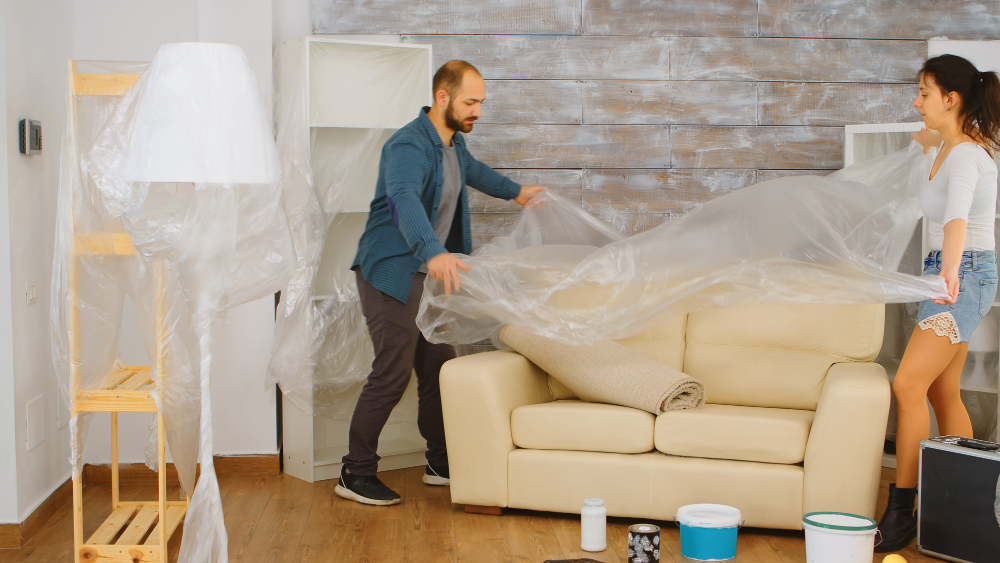Home renovation is a rewarding yet challenging endeavor, transforming your living spaces in a way that reflects your taste and lifestyle. This process, however, requires meticulous planning and execution.
Beyond selecting the right materials, designs, and contractors, one critical aspect that often gets overlooked is the safeguarding of personal belongings. Protecting your possessions is paramount during the renovation phase to avoid damage caused by dust, paint splatters, and accidental mishandling.
Neglecting this step could lead to unnecessary additional costs to repair or replace items. In the following sections, we will guide you through effective strategies to ensure the safety of your belongings while your home is transformed into your dream space.
Inventory of Items

Make a comprehensive list of all items in your home. This will help you prioritize what needs protection and what can be moved or stored elsewhere. Moreover, if you want, this will also help you with finding the right storage for your needs, as you will know the amount of space required.
Start with larger items like furniture, appliances, and electronics and then move on to smaller items such as decorations, books, and clothing. As you go through this process, consider the value of each item and its susceptibility to damage during renovation. For example, fragile items like vases or paintings might need extra care compared to sturdier items like a dining table.
Secure Storage
Consider renting a secure storage unit for valuable items or belongings that could be damaged during the renovation process. Storage units offer a safe, climate-controlled environment to keep your items protected until the renovation is complete.
And in the process of finding a storage option for your needs, there are plenty of things to consider. From the longevity of the items to their durability and importance, make sure you go through everything.
This option is especially useful if you have delicate or antique furniture that cannot be easily moved or requires special handling. Storage units also provide added security against theft or damage caused by any unforeseen circumstances like fire or water leaks.
Protection Covers

Use protective covers like drop cloths or plastic sheets to cover your furniture and other larger items. This will prevent dust and paint from damaging them.
Additionally, use masking tape to cover any exposed surfaces or openings in furniture to keep out excess dust. For electronics like TVs and appliances, consider using bubble wrap for added protection. Furthermore, ensure that all items are covered tightly and securely to avoid any damage caused by movement or accidents.
For smaller items, consider using plastic bins or boxes with lids to store them away safely. Although these covers may take some time to set up and remove, they are a cost-effective way to safeguard your items during renovations.
Room-by-room Cleaning
Clean each room after the day’s work is done to minimize the possibility of dust and debris damaging your belongings. Start by sweeping or vacuuming the floors, walls, and ceilings to remove any dust. Then wipe down surfaces like countertops, shelves, and tables with a damp cloth to remove any remaining debris.
For delicate items such as chandeliers or light fixtures, cover them with plastic bags and secure them tightly to protect against damage. This daily cleaning routine may seem time-consuming, but it will save you the hassle of having to deep clean your belongings once the renovation is complete.
Communication with Contractors
Communicate clearly with your contractors about areas with precious or fragile items. By informing them in advance, you can ensure these items get extra care. Additionally, ask them to cover any exposed items or areas with protective materials before starting their work.
It would help if you also discussed the post-renovation cleaning process with your contractors to ensure that all debris and dust are thoroughly removed from your home. When working together, you can prevent any damage from occurring to your possessions and ease your worries during the renovation process.
Even with all the precautions, accidents can still happen. Therefore, make sure to have insurance coverage that includes home renovation damages to protect you against any unexpected mishaps.
Insurance
Check your homeowner’s insurance policy to see if it covers any damages that may occur during the renovation process. If it doesn’t, you might want to consider purchasing additional coverage. This extra insurance will provide peace of mind and ensure that any damages or losses caused by the renovation process are covered.
It is always better to be safe than sorry when it comes to protecting your belongings. If you are renting, make sure to contact your landlord and discuss any necessary insurance coverage for the rental property.
Even if your landlord has insurance, it may not cover any damages to personal belongings during a renovation. Most importantly, make sure to keep an inventory of all your items and take pictures before the renovation begins.
The Takeaway
Safeguarding your possessions during home renovations is crucial in ensuring a smooth and stress-free process. By taking inventory, using protective covers, securing storage, cleaning regularly, communicating with contractors, and having insurance coverage, you can protect your belongings and focus on creating your dream home.
With these strategies in mind, you can rest assured that your personal belongings will remain safe throughout the renovation process. So go ahead and start planning for your renovation project without any worries! There are also some additional measures you can take to secure your belongings if needed.
Related Stories
- Maximize Your Space: 8 pro Tips for Home Decluttering with Self-storage Bliss
- 6 Top Tips for Harnessing the Power of Self Storage
- Top 4 Tips to Declutter Your Home Before Moving Out
- The Process of Roof Renovation: 6 Essential Tips You Should Follow
- Essential Tips for Post-renovation Cleaning
Recap
